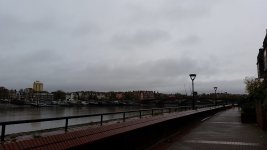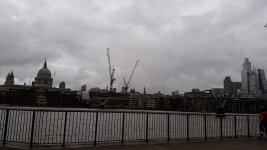This my experience as well, though I would reverse which model I see most of. ELs far outnumber NLs here. Sorta makes sense based on how long theyve been around...I don't think they really have a reputation outside of this forum from a few vocal critics - if they were as problematic as a few suggest for most people I'm sure they'd have changed the design. I've no idea of sales figures, but on the local reserves they're clearly the most popular binoculars amongst the serious regular birders, with ELs coming a close second. You get the odd pair of SFs or Ultravid (both fine binoculars with different design compromises) and some very experienced serious birders using binoculars that wouldn't get that horrible 'alpha' tag too.
-
Welcome to BirdForum, the internet's largest birding community with thousands of members from all over the world. The forums are dedicated to wild birds, birding, binoculars and equipment and all that goes with it.
Please register for an account to take part in the discussions in the forum, post your pictures in the gallery and more.
You are using an out of date browser. It may not display this or other websites correctly.
You should upgrade or use an alternative browser.
You should upgrade or use an alternative browser.
Swarovski glare/flare is deliberate by design? A comparison with Leica (5 Viewers)
- Thread starter kimmik
- Start date
More options
Who Replied?james holdsworth
Consulting Biologist
Calling out the only person here that does actual non subjective testing…bad form, IMO.Can you show the Noctivids, Ultravids, EL‘s, SF’s, FL’s, and a few others so we can see the difference comparing to the NL? And dont forget we’ll need multiple samples to make sure it’s not a specimen issue.
kimmik
Well-known member

I kinda doubt that baffling would have any affect on light throughput or vignetting of the image, but I’d love to hear Henry’s take on this.
Regarding baffle effects:
A baffle at the aperture is aka aperture stop.
A baffle at the focal point is aka field stop.
Any baffle in between is a vignette, and can be tightened to reduce stray light, or opened to reduce vignette.
My other thread on exit pupils and blackout has an experiment showing a tightened baffle on peripheral vignette.
Last edited:
What about Gils, Kimmik? Gils having use of a lab with real test equipment seems rather more valuable, than say flashlights and cell phones. Not all non subjective testing is equal. Theres plenty of bad form to go around here including myself from time to time. It happens when opinions, intuition, conjecture stand in lieu of facts.Calling out the only person here that does actual non subjective testing…bad form, IMO.
Paultricounty
Well-known member

I know, I was being a flippant, And no doubt he’s good. It’s just to me so much of these tests using equipment don’t always mean much if it can’t be seen while observing. Its similar to allbinos testing, many times the numbers don’t equate to what the observer sees.Calling out the only person here that does actual non subjective testing…bad form, IMO.
The EL 8x32 prism baffle is on the other hand as open as possible, almost touching the prism edges:
1. Bright image across the entire field. In dim light, the periphery was actually brighter than noctivid 8x42, though center was a little dimmer. The round pupil extends almost to the edge, where the noctivid has highly almond shaped pupil.
2. Some internal reflections and glare get through.
I remember someone (I thought it was Paultricounty but after a quick search realized it was Torview) once saying that Swarovskis audition very well, or words to that effect. Perceived brightness may be part of that. I do think that on grotty grey days like today (your location says London, so you would know what it was like today and on many days through the autumn, winter and early spring), glare is the least of your problems, and every smidgen of brightness, real or perceived, is nice to have.
Now maybe resistance to glare is vital to the LEICAMAN (thank you Ken Rockwell ...
Attachments
crinklystarfish
Well-known member

I have the same experience on dark days and even well after sunset when examining a dark landscape under a twilight sky. The glare in those situations can be more clearly visible than when looking at a very bright area near the sun where the internally generated glare may be totally lost in the overall brightness of the object field.
That's exactly my experience of the phenomenon and accounts for why I find 'diffuse light' glare more of a spoiler than near-sun 'flare' experienced on bright and clear days.
I know you've analysed, quantified and explained the cause of the phenomenon before (on several threads) so it seems both odd and rather sad to me that though some people clearly aren't so troubled by this issue that they would seek to dismiss the phenomenon as a delusion, or perhaps something only suffered by unskilled fools.
Indeed, we might well wonder what forum users who take to their keyboard mainly to deride will do when the power is out.
More generally, given that eye placement would seem to be a significant factor, it seems perfectly logical to me that an individual's eye-socket depth and associated facial structure could well account for why some experienced users of binoculars are more troubled than others by this phenomenon when using exactly the same instrument.
Last edited:
kimmik
Well-known member

A direct comparison of exit pupil and internal reflections of EL and Noctivid.
1. As described before, center exit pupil is bigger in Noctivid (as expected, 42/8=5.25mm, 32/8=4mm)
2. Edge exit pupil is bigger in the EL, which stays almost unchanged in size
3. The wide open EL baffles let internal reflections through, showing around the central exit pupil.
The two brightest spots are just eyepiece reflections and are not visible when in use, similarly the other "stuff" around the same distance are not visible either.
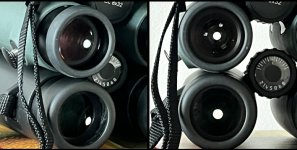
1. As described before, center exit pupil is bigger in Noctivid (as expected, 42/8=5.25mm, 32/8=4mm)
2. Edge exit pupil is bigger in the EL, which stays almost unchanged in size
3. The wide open EL baffles let internal reflections through, showing around the central exit pupil.
The two brightest spots are just eyepiece reflections and are not visible when in use, similarly the other "stuff" around the same distance are not visible either.


I've not seen anyone claim that glare is a delusion, just that for most people it isn't a major issue once they've got the IPD and eyecup depth adjusted correctly.That's exactly my experience of the phenomenon and accounts for why I find 'diffuse light' glare more of a spoiler than near-sun 'flare' experienced on bright and clear days.
I know you've analysed, quantified and explained the cause of the phenomenon before (on several threads) so it seems both odd and rather sad to me that though some people clearly aren't so troubled by this issue that they would seek to dismiss the phenomenon as a delusion, or perhaps something only suffered by unskilled fools.
Indeed, we might well wonder what forum users who take to their keyboard mainly to deride will do when the power is out.
More generally, given that eye placement would seem to be a significant factor, it seems perfectly logical to me that an individual's eye-socket depth and associated facial structure could well account for why some experienced users of binoculars are more troubled than others by this phenomenon when using exactly the same instrument.
Obviously facial structure, lens thickness/curve for glasses wearers may make it harder for some people to achieve an optimum eye placement, and it might not be possible for everyone. Just as with some some older binoculars with exceptionally wide FoV won't work for everyone.
I think this maybe the reason, at least in part. I have a pair of Habicht 8x30; by common consent, renowned for its glare. Yet, in the 7 years that I have had them, I can only recall one bad instance and one minor instance. The other day I tried them in really challenging conditions and had no problems at all either with or without glasses. What I should have done is pass them to my wife and see if she had any problems - but I didn't so a rather limited test!More generally, given that eye placement would seem to be a significant factor, it seems perfectly logical to me that an individual's eye-socket depth and associated facial structure could well account for why some experienced users of binoculars are more troubled than others by this phenomenon when using exactly the same instrument.
kimmik
Well-known member

Snow and frosted park this morning, took out both the EL and Noctivid as it was a good time to test glare resistance, considering that the sky and ground are both whited out!
If some of the posts are to be believed, there would be no image left to see in a swaro EL under such horrendous conditions... So vote away, which is which and what do you prefer.
1.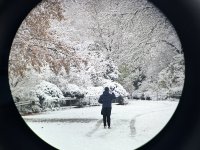 2.
2. 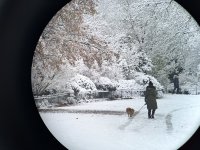
If some of the posts are to be believed, there would be no image left to see in a swaro EL under such horrendous conditions... So vote away, which is which and what do you prefer.
1.
 2.
2. 
Last edited:
William Lewis
Wishing birdwatching paid the bills.

Bottom image for me, less ca. Sharper edges, wider field, higher contrast. Which ones that?
Paultricounty
Well-known member

The one with the guy in the picture is the Swaro. Unless the camera is changeing things the tree on the left is sharp to the edge. And I don’t see any glare in either one.Snow and frosted park this morning, took out both the EL and Noctivid as it was a good time to test glare resistance, considering that the sky and ground are both whited out!
If some of the posts are to be believed, there would be no image left to see in a swaro EL under such horrendous conditions... So vote away, which is which and what do you prefer.
View attachment 1483241View attachment 1483242
Click on the images to open them and then magnify the images by clicking the + symbol and its the image on the right with the lady and dog in which the tree is sharp to the edge.The one with the guy in the picture is the Swaro. Unless the camera is changeing things the tree on the left is sharp to the edge. And I don’t see any glare in either one.
Lee
A2GG
Beth

I don’t see higher contrast in the bottom image. To me it looks more blue tint in the image.Bottom image for me, less ca. Sharper edges, wider field, higher contrast. Which ones that?
You can see it in the branches to the right and snow in front of the man walking (in the background).
I think the bottom/2nd image is the Swarovski. I prefer the top/1st image.
Wish I could look through these binos myself.
Paultricounty
Well-known member

I think you're right , and less CA. Both images are extremely good and equal on glare as far as my eyes can see. We don’t how much the camera is effecting the outcome of the image.Click on the images to open them and then magnify the images by clicking the + symbol and its the image on the right with the lady and dog in which the tree is sharp to the edge.
Lee
Last edited by a moderator:
Paultricounty
Well-known member

I seen that as well, but thought it was more to do with change in lighting considering the pictures were not taken immediately one after the other.I don’t see higher contrast in the bottom image. To me it looks more blue tint in the image.
You can see it in the branches to the right and snow in front of the man walking.
I think the bottom/2nd image is the Swarovski. I prefer the top/1st image.
Wish I could look through these binos myself.
Paultricounty
Well-known member

Are both 10x or the 8x and 8.5x?Snow and frosted park this morning, took out both the EL and Noctivid as it was a good time to test glare resistance, considering that the sky and ground are both whited out!
If some of the posts are to be believed, there would be no image left to see in a swaro EL under such horrendous conditions... So vote away, which is which and what do you prefer.
View attachment 1483241View attachment 1483242
A2GG
Beth

It could be but I suspect it’s just the colder color of the Swaro. In both photos the left side showing the snow covered foliage is brighter white and looks similar to each other. The background and more to the right is a grayer area. It’s in these grayish areas where you can see color tint from my experience. I’ve seen the greenish in the FL and Yellow in the MHG show up looking in these dull gray spots with dimmer lighting. My old Swaro CL never really showed any tint in comparison. In these pics there’s also snow which helps to further reveal the color bias in the grayish area. The above IMO and from my personal experience of course.I seen that as well, but thought it was more to do with change in lighting considering the pictures were not taken immediately one after the other.
William Lewis
Wishing birdwatching paid the bills.

I suppose it's micro contrast I'm referring to, the spindly branches of the oak tree seemed better defined in the bottom image but also the dark shrub (looks like a yew) that's overhanging the black metal fence has more detail revealed in the lower image.




